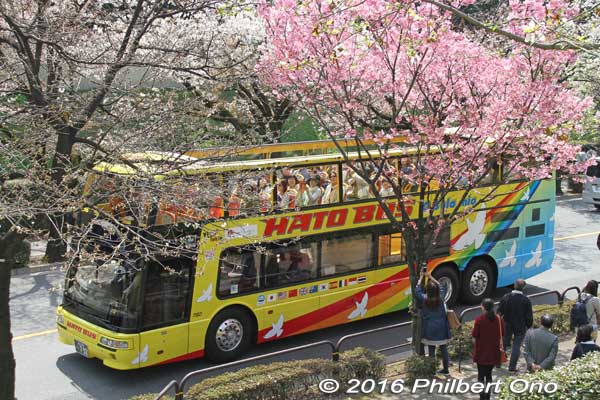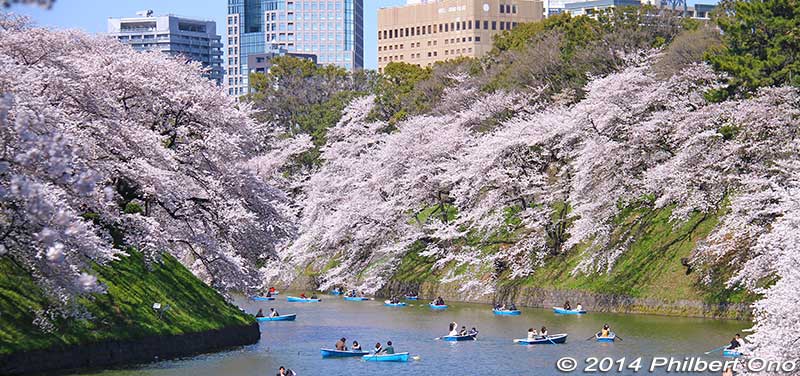
Updated: March 25, 2023
Happy spring! Here’s an illustrated list of Tokyo’s top cherry blossoms (sakura). I’ve included both famous (crowded) and not so famous spots in central, western, and eastern Tokyo. In Tokyo, most cherry blossoms bloom from mid-March to early April, usually peaking in late March.
Weeping cherry blossoms and early bloomers such as Kawazu-zakura cherry blossoms bloom earlier in early or mid-March.
If you like to take pictures of cherry blossoms, the best time is when they are in full bloom on a sunny, blue-sky day. However, such ideal conditions can be elusive. Often times, the weather is rainy, windy, or overcast right during peak bloom (two or three days). So many sakura spots, so few sunny days. It took me years to compile these sunny photos of cherry blossoms in Tokyo. Had fun doing it though.
Consider yourself lucky if you see cherry blossoms in full bloom on a sunny day. If there’s no blue sky, the alternative is to see it at night if the flowers are illuminated.
During the COVID-19 pandemic, there were restrictions on hanami flower-viewing picnics, but all have been lifted from March 2023. We can expect cherry blossoms to be jammed with people in spring 2023 due to pent-up demand and the release of COVID stress after three years. The only damper might be rainy weather.
Although mask-wearing is optional, wearing a mask in crowds is recommended. It’s also hay fever season in Japan, so expect to see many people still wearing a mask.
For the current blooming status at major cherry blossom spots in Tokyo, see WeatherNews sakura page for Tokyo (in Japanese). Click on the name of the cherry blossom spot below to see more photos. All these places below have free admission or a low admission fee (gardens). Renting a rowboat, etc., costs extra.
Central Tokyo
- Chidorigafuchi, Chiyoda-ku
- Imperial Palace Inui-dori, Chiyoda-ku
- Ueno Park, Taito-ku
- Sumida Park, Taito-ku & Sumida-ku
- Shinjuku Gyoen Garden, Shinjuku-ku
- Rikugien Garden, Bunkyo-ku
- Koishikawa Korakuen Garden, Bunkyo-ku
- Harimazaka, Bunkyo-ku
- Urban Agricultural Park, Adachi-ku
- Yasukuni Shrine, Chiyoda-ku
- Sotobori Canal, Chiyoda-ku
- Yanaka Cemetery, Taito-ku
- Zojoji Temple and Shiba Park, Minato-ku
- Yoyogi Park, Shibuya-ku
- Meguro River, Meguro-ku
Western Tokyo
- Inokashira Park, Mitaka
- Koganei Park, Koganei
Eastern Tokyo
- Kinshi Park, Sumida-ku
- Oyoko River, Koto-ku
- Shinkawa River Senbonzakura, Edogawa-ku
- Komatsugawa, Edogawa-ku
 Chidorigafuchi (千鳥ヶ淵), Chiyoda-ku
Chidorigafuchi (千鳥ヶ淵), Chiyoda-ku
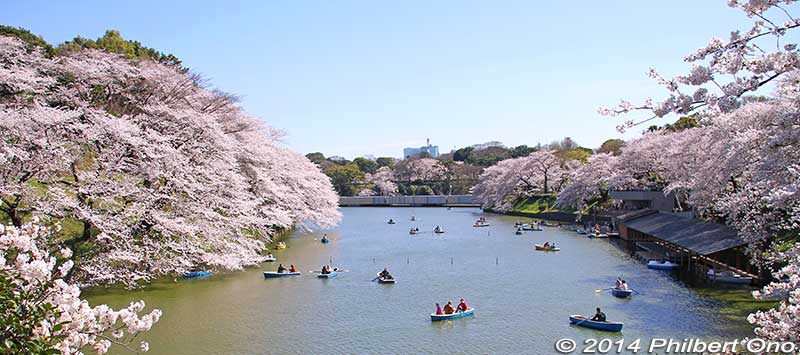
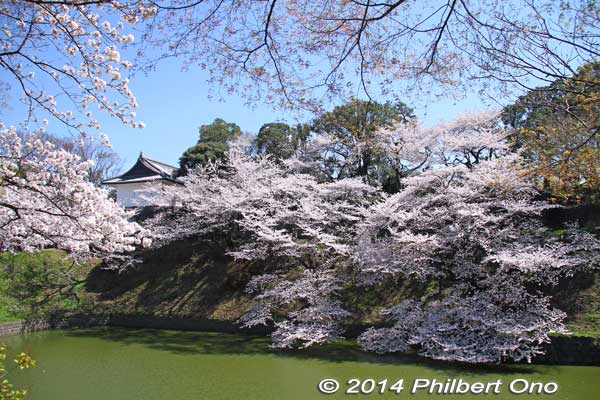
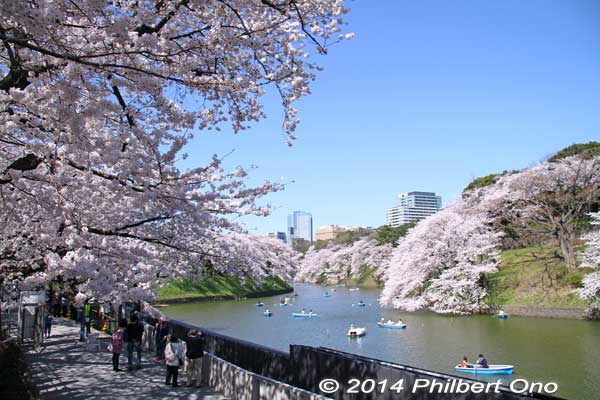
Cherry blossoms along the huge Chidorigafuchi moat of the Imperial Palace (former Edo Castle) makes this one of Tokyo’s most photogenic and popular spots. There is also a pleasant path to walk through the cherries along the moat between Kudanshita and Hanzomon subway stations. Be prepared for the crowds. Also beautiful at night. Near Kudanshita Station (Tozai Line). Map here.
 Imperial Palace Inui-dori (皇居乾通り一般公開), Chiyoda-ku
Imperial Palace Inui-dori (皇居乾通り一般公開), Chiyoda-ku

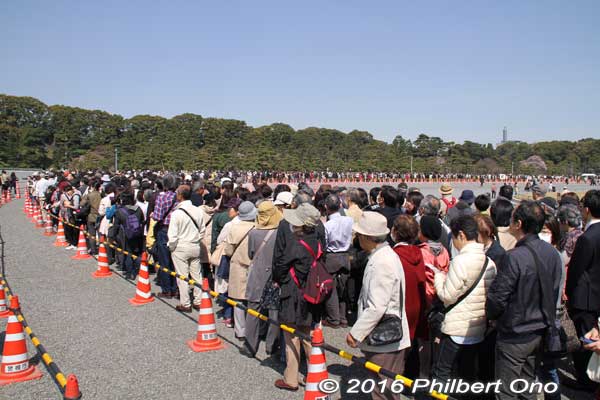
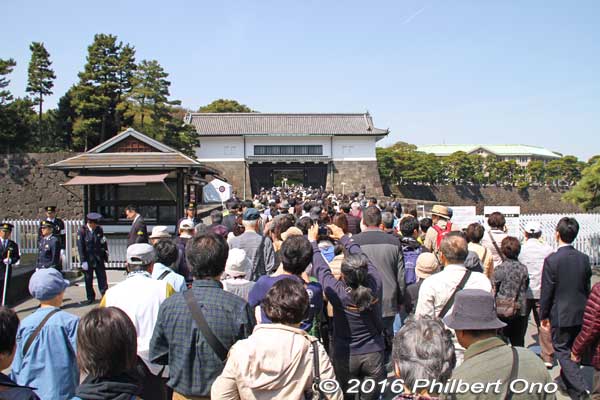

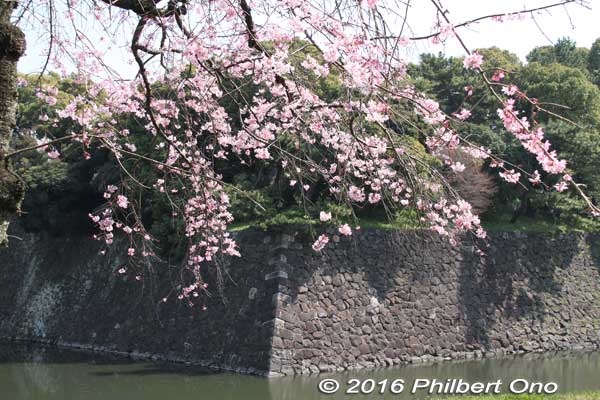
In the Imperial Palace, Inui-dori is a 600-meter path lined with cherry trees along a palace moat. The path starts from Sakashita Gate and ends at Inui Gate (exit only). Since 2014, Inui-dori has opened to the public for about 10 days in late March for cherry blossoms and November for fall leaves.
No hanami picnicking allowed, just stroll though. In spring 2023, the path will be open to the public from March 25 to April 2, 2023 from 9:00 a.m. to 3:30 p.m. (exit by 4:00 p.m.) This should be when the cherry blossoms are peaking.
It’s not a spectacular cluster of cherry blossoms, and Inui-dori is somewhat overrated I think, but it does have the aura and exclusivity of the Imperial Palace. You can get a few good shots of sakura with the palace moat or stone wall in the background.
No reservations required, but be prepared for a long line to get in and a bag search. Took me 15 min. of standing still before the line started moving and we got in quickly. If you are not carrying any bags, you can pass through security faster. If it’s sunny, it can get quite hot waiting in line. Bring an umbrella or hat for shade. Free admission.
After exiting through Inui Gate, you will be on the opposite side of the palace. You can walk around the palace to get back to Tokyo Station, etc. Or walk to Takebashi Station (Tozai Line), the closest subway station.
Sakashita Gate is near Tokyo Station, Otemachi Station, and Nijubashi Station. Follow the crowd (long line). Official info here (be sure to read before going). Map here.
 Ueno Park & Shinobazu Pond (上野公園・不忍池), Taito-ku
Ueno Park & Shinobazu Pond (上野公園・不忍池), Taito-ku

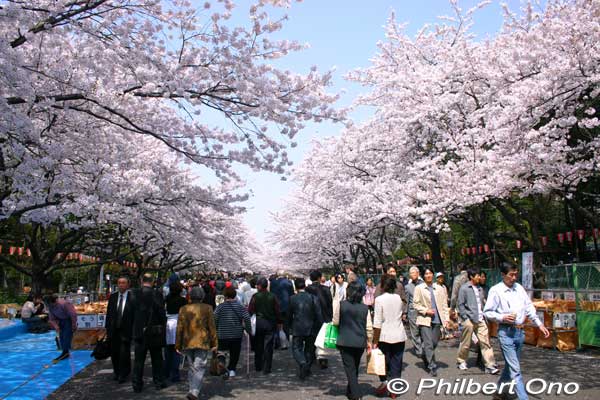
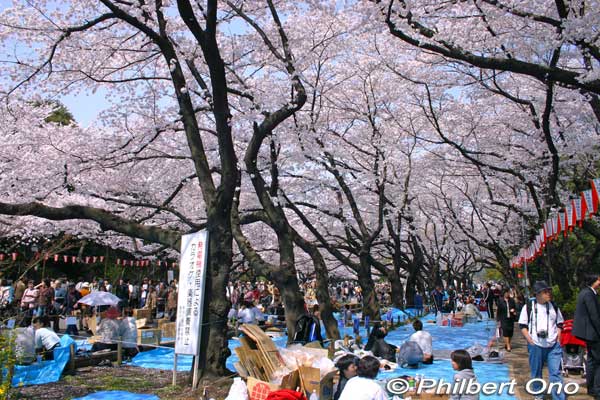
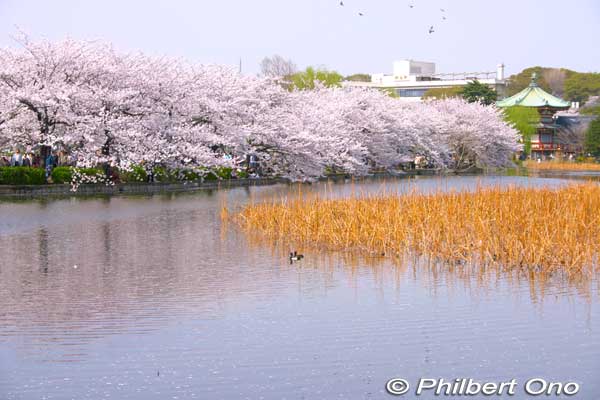
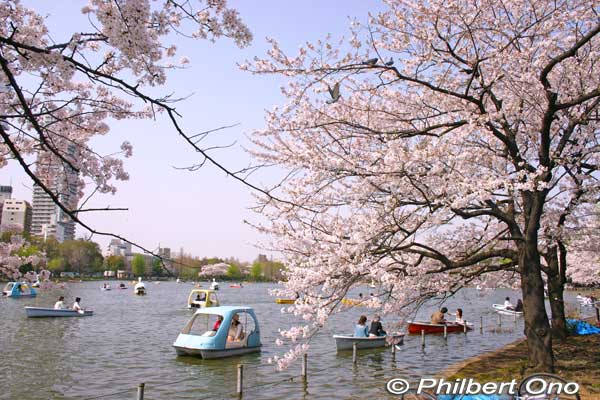
One of Tokyo’s biggest outdoor hanami picnic parties are held in Ueno. The best spots are reserved hours in advance with tarps. The flowers are also lit up at night. If you want to know what hanami is like, come to Ueno. During the pandemic, people were not allowed to have hanami flower-viewing picnics here. It was unimaginable, but from spring 2023, all restrictions have been lifted.
To escape the madness of Ueno Park, go to the adjacent Shinobazu Pond, picturesque for a stroll through the sakura. The park also has a large zoo (pandas) and many major museums. Near Ueno Station. Map here.
 Sumida Park (隅田公園), Taito-ku and Sumida-ku
Sumida Park (隅田公園), Taito-ku and Sumida-ku
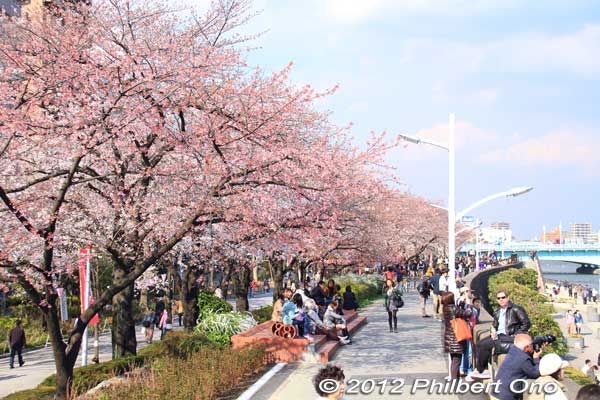
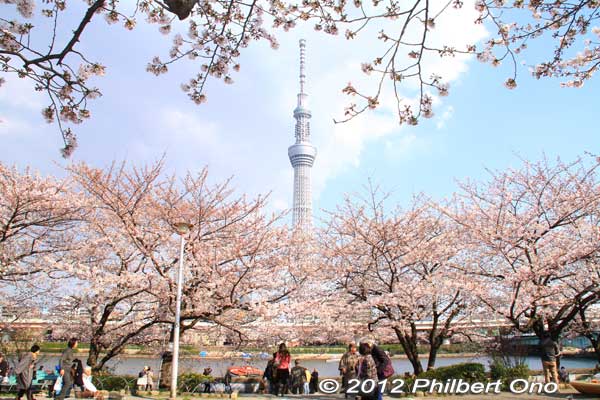
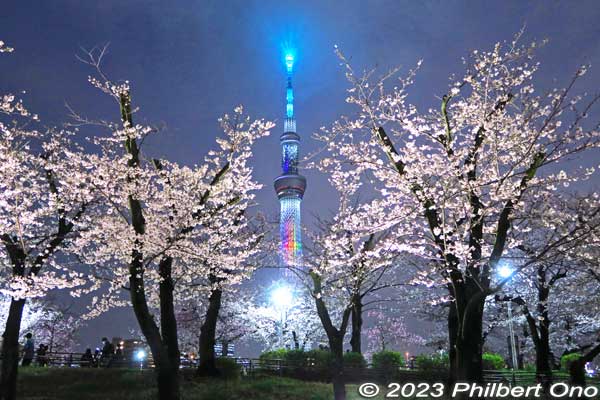
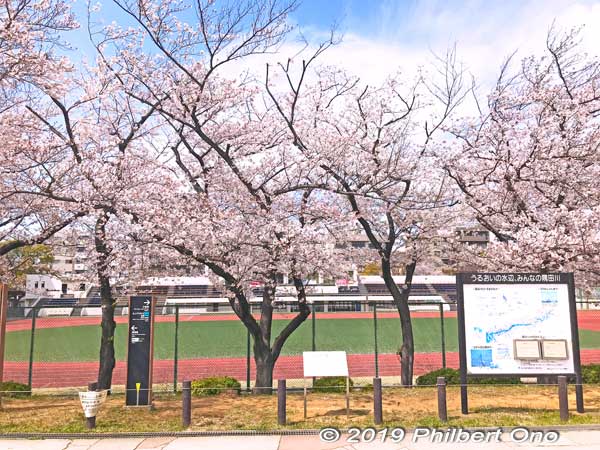
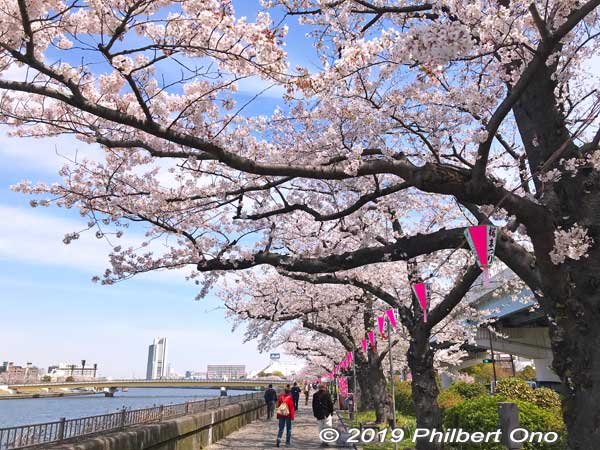
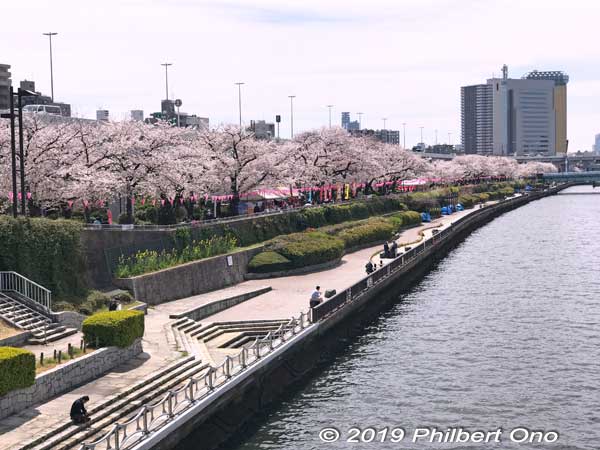

Sumida Park is a riverside park along Sumida River near Asakusa. Both sides of the river are lined with many cherry trees. The Asakusa side (west riverside) is Taito Ward/City, while the Tokyo Skytree side across the river is Sumida Ward/City in the east.
The cherry trees were originally planted on both sides of Sumida River in 1717 as ordered by Shogun Tokugawa Yoshimune.
The main draw for photographers is the cherry blossoms with Tokyo Skytree in the background. The flowers and Skytree are both lit up at night too. Near Asakusa Station. Map here.
 Shinjuku Gyoen National Garden (新宿御苑), Shinjuku-ku
Shinjuku Gyoen National Garden (新宿御苑), Shinjuku-ku
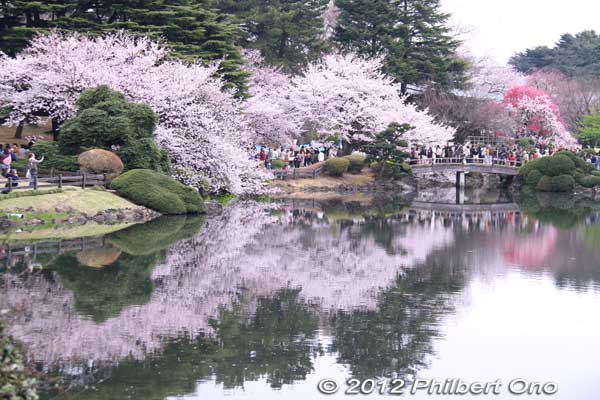
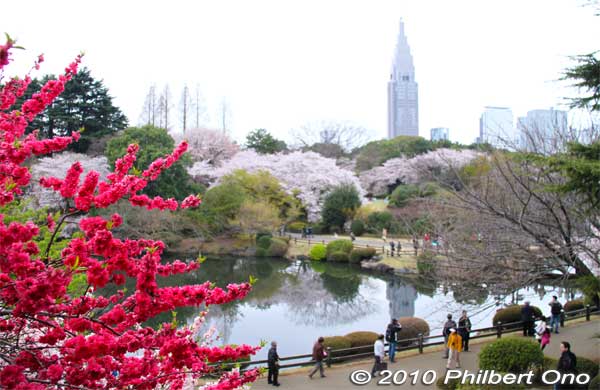
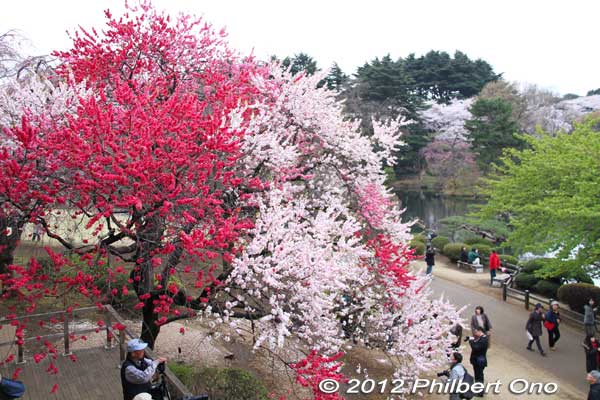
After Ueno Park, this huge garden-park is massively popular for hanami picnics. Unlike Ueno Park, there’s lots of open, grassy space and room for picnickers.
The garden itself is great to walk around too with a variety of gardens, landscapes, and flowers. The park charges a small admission fee. Near Shinjuku Gyoen-mae Station on the Marunouchi Line. Map here.
 Rikugien Garden (六義園), Bunkyo-ku
Rikugien Garden (六義園), Bunkyo-ku
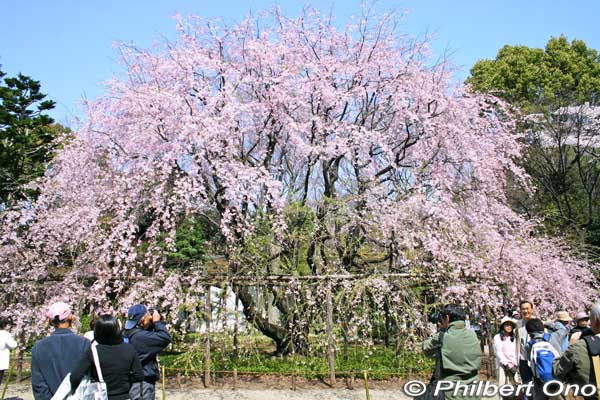
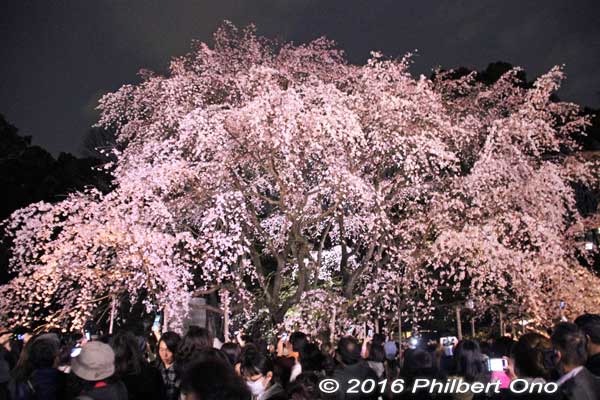
Rikugien is one of two of Edo’s famous gardens (other is Koishikawa Korakuen). Noted for a beautiful weeping cherry tree. This weeping cherry tree blooms earlier (around March 20) than regular cherry blossoms. See the official Twitter account to see the current blooming status.
Expect a line at the entrance when the tree is in bloom. Enter by 4:30 pm during the day (go earlier due to the waiting time), or go in the evening when it is illuminated from 6:30 p.m. to 9:00 p.m. on March 23rd–29th, 2023. Also lit up at night. The garden also has another large cherry tree lit up at night.
The garden charges a small admission fee. Near Komagome Station on the Yamanote Line. Map here.
 Koishikawa Korakuen Garden (小石川後楽園), Bunkyo-ku
Koishikawa Korakuen Garden (小石川後楽園), Bunkyo-ku
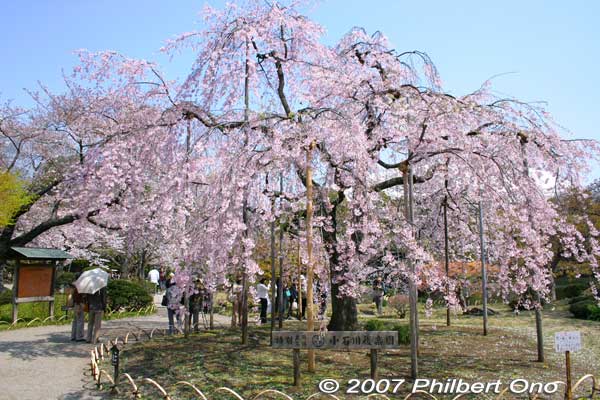
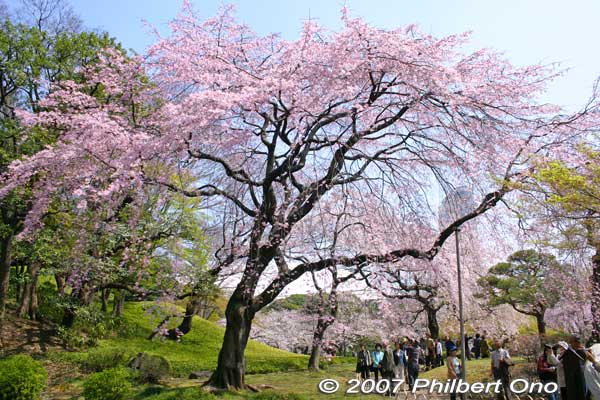
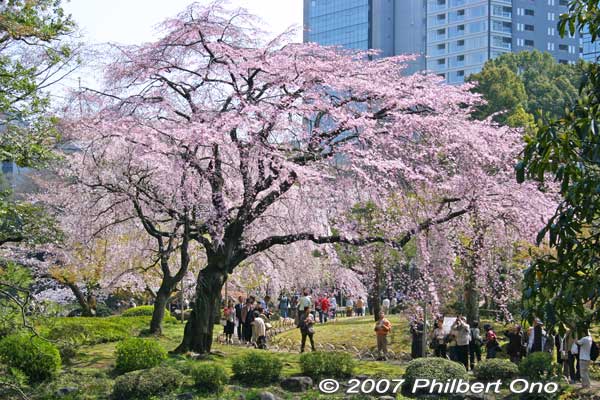
Koishikawa Korakuen is another famous Edo-Period Japanese garden. Originally built by Lord Yorifusa of the Mito Tokugawa Clan in 1629 as part of his Edo estate. The garden was completed under Lord Mitsukuni, the second lord of the Mito clan. Famous for aesthetic weeping cherry trees and other flowers.
The weeping cherry tree blooms earlier (around March 20) than regular cherry blossoms. See the official Twitter account to see the current blooming status.
The garden charges a small admission fee. Near Iiidabashi Station (JR Sobu Line) and Korakuen Station subway. Map here.
 Harimazaka (播磨坂桜並木), Bunkyo-ku
Harimazaka (播磨坂桜並木), Bunkyo-ku
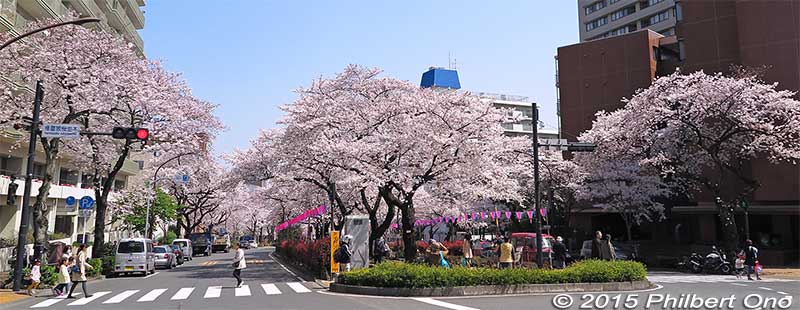
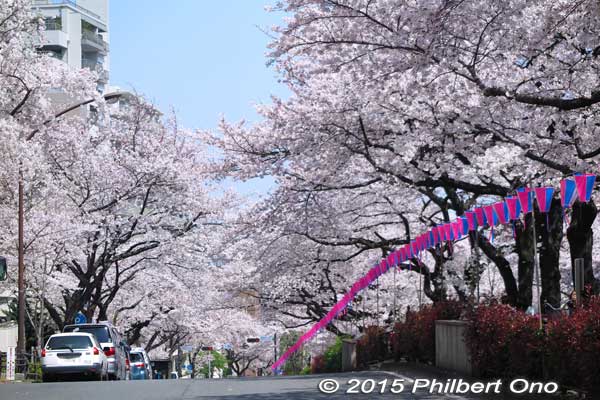
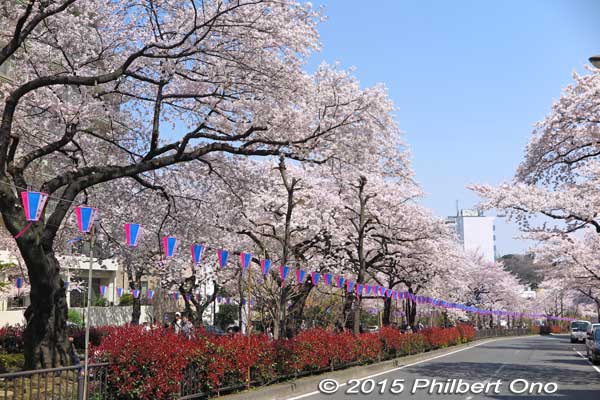
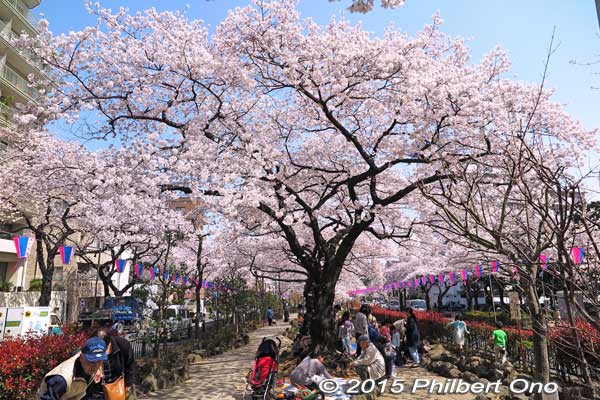
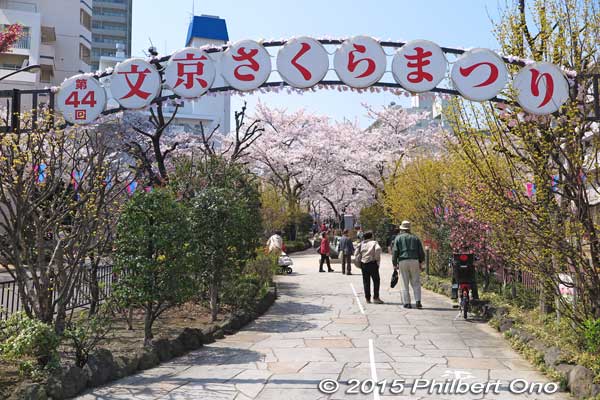
Harimazaka road, named after Lord Matsudaira Harima who had his main residence here during the Edo Period, is lined with 127 cherry blossom trees for about 460 meters along a wide, central median. The cherry trees were planted in 1960. A few outdoor sculptures complement the trees.
On weekends, the road is closed to traffic so we can enjoy the blossoms more. Near Myogadani Station on the Marunouchi Line. Map here.
 Adachi Urban Agricultural Park (都市農業公園), Adachi-ku
Adachi Urban Agricultural Park (都市農業公園), Adachi-ku

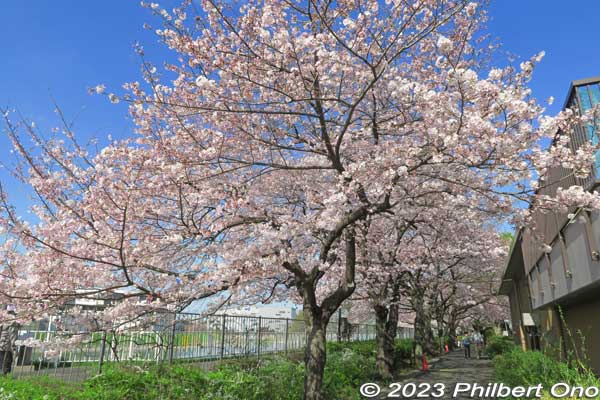
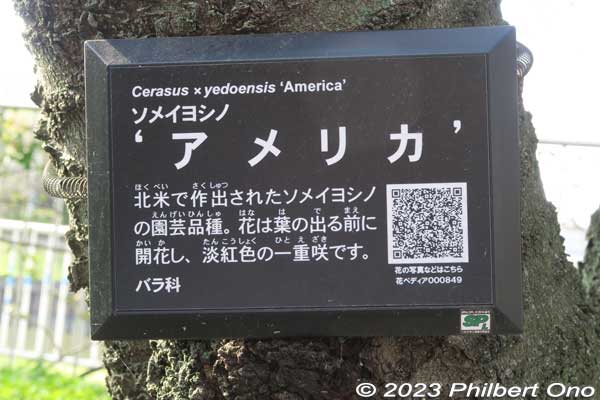
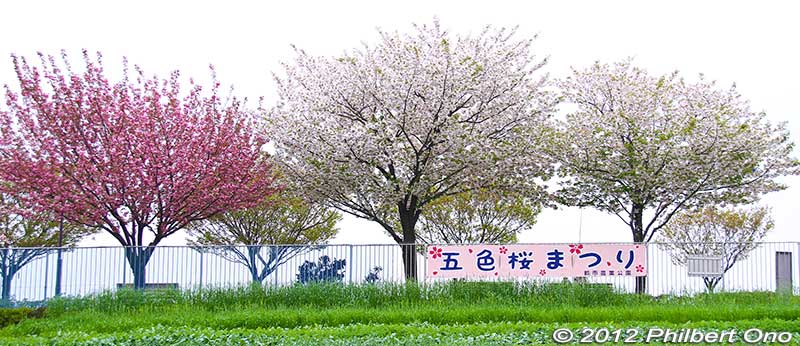
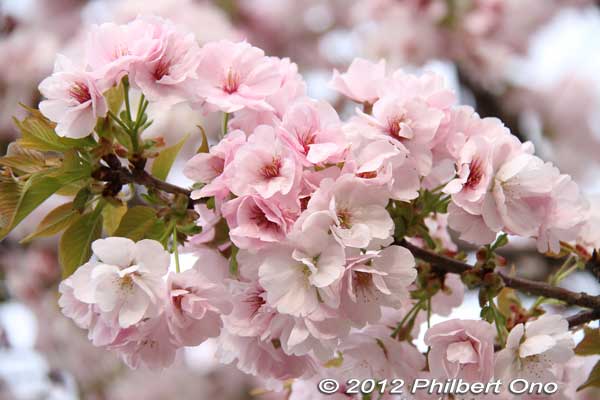
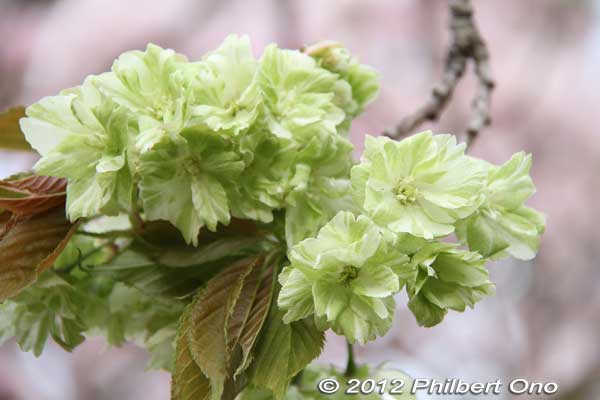
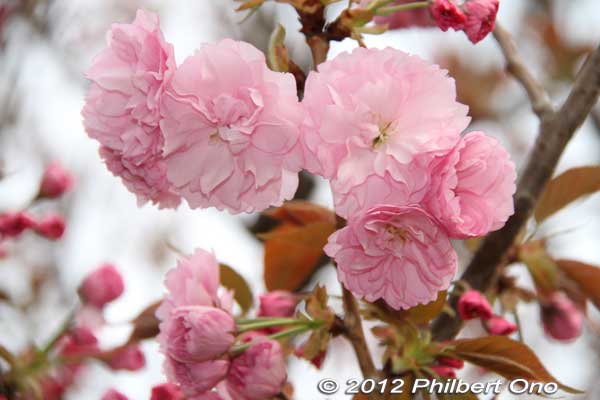
Adachi Urban Agricultural Park might be out of the way for the average tourist, but if you’re American, you should know that the famous cherry trees in Washington, DC came from here, in the old Kohoku Village (江北村) now in Adachi City.
It started in 1886 when local villagers planted cherry trees along Arakawa River here. They planted a variety of cherry blossoms in different colors like pink, light pink, white, green, and dark pink. They were collectively called “goshiki-zakura” (五色桜), literally cherry blossoms in five colors and became quite famous.
So famous that in 1912, 3,000 cherry tree samplings from Kohoku Village were gifted to Washington, DC as a gesture of friendship from Japan. Twelve species of cherry trees thereby famously decorated the Potomac River in America’s capital.
However, back in Kohoku Village, most of the cherry trees were decimated by World War II and by urban development and the rerouting of the river. So in 1981, the Adachi Ward/City and Tokyo governments asked Washington, DC for cherry tree saplings from the cherry trees which originated from Adachi Ward.
The cherry trees from America became “homecoming cherry trees” (里帰りの桜) and were planted here in Adachi Ward’s Urban Agricultural Park (Toshi Nogyo Koen). The Somei-Yoshino cherry trees from Washington, DC were named “America” and they bloom in latter March along Shin-Shibakawa River in the park.
Also, U.S. President Ronald Reagan’s wife Nancy, Honorary Chairman of the Washington Cherry Blossom Festival, donated a Somei-Yoshino cherry tree sapling to Adachi City (photo below) in 1981. It is in Toneri Park, also in Adachi Ward and not far from the Urban Agricultural Park.
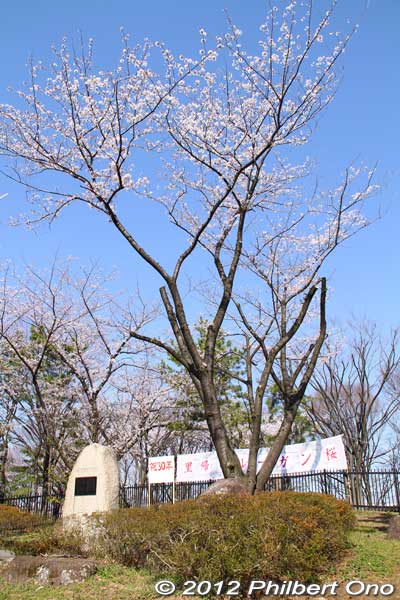
Today, Urban Agricultural Park thrives with many colorful varieties of cherry blossoms blooming from early March to late April. They have cherry trees along two rivers and in a circular, grassy lawn for hanami picnics and kids to run around.
Out of the park’s 250 cherry trees, a good number came from Washington, DC. And many of the species which were originally planted in the 19th century have been resurrected here too.
The Somei-Yoshino cherry trees from Washington, DC have grown quite large. They must be happy to be back in the land of their ancestors. If the trees were human, they would be called kikoku shijo (帰国子女) or “returnee children.”
The park also has other flowers like tulips, a vegetable garden, visitors center, farmer’s market, old farmhouse, and a rest house with a restaurant (closed Wed. and Thu.).
If you want to see or study different species of cherry blossoms, this park is a must-see. Prime time is late March to early April. However, they also have early- and late-blooming cherry blossoms. They even have cherry blossoms which bloom in winter.
In early April, the park conducts free 30-min. guided tours (桜のガイドウォーク) of the park’s cherry blossoms. In 2023, guided tours will be held on April 3, 4, 5, and 6 at 10:30 a.m. and 1:30 p.m.
Park is open 9:00 a.m.–4:30 p.m. (till 5:30 p.m. during May to Aug.) Closed on the first and third Wed. of the month and Dec. 29–Jan. 1. Free admission.
The park is wheelchair accessible. Pets are not allowed in the park except for guide dogs. Official website (in Japanese).
From Nishi-Arai Station (east exit) on Tobu Railway, take a bus bound for Shikahama Toshi Nogyo Koen (鹿浜都市農業公園) and get off at the last stop (Shikahama Toshi Nogyo Koen). Takes about 20 min. Map here.
If you have time, also visit Toneri Park to see the Reagan Sakura and more cherry blossoms. The bus stops at Nishi-Arai Daishi Nishi Station (西新井大師西駅) on the Nippori-Toneri train line. Then take the train to Toneri Koen Station two stops away. Map here
 Yasukuni Shrine (靖國神社), Chiyoda-ku
Yasukuni Shrine (靖國神社), Chiyoda-ku
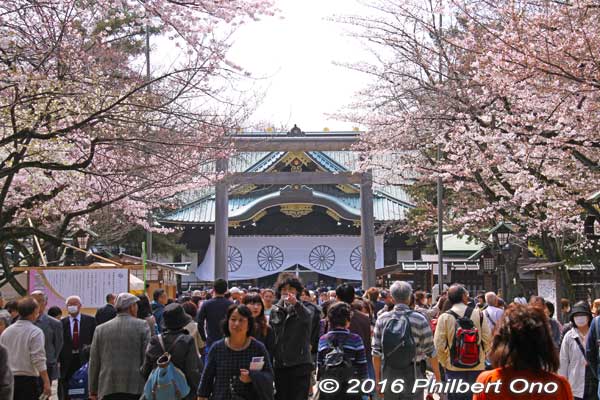
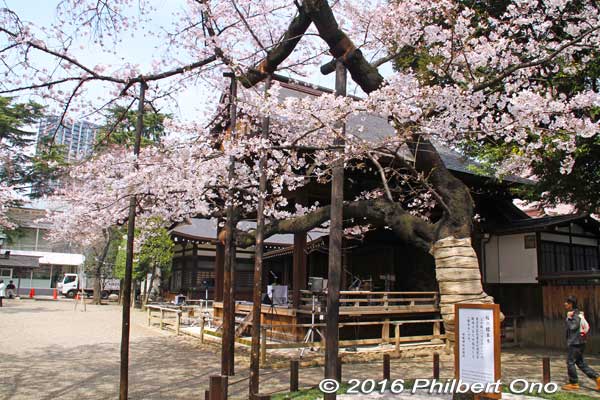
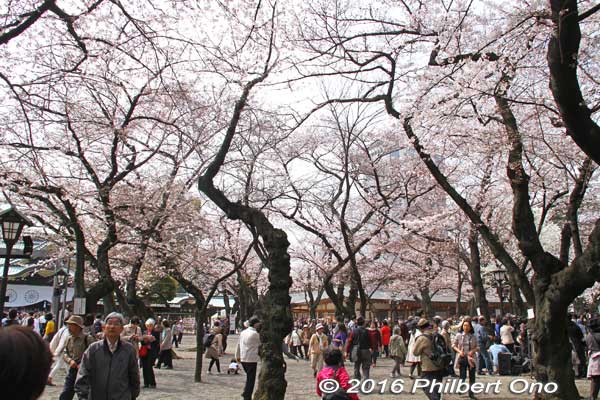
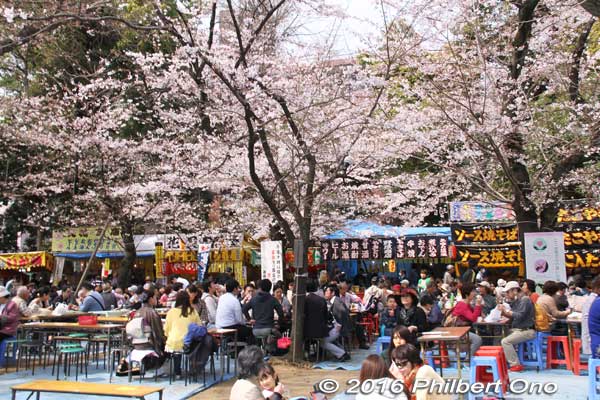
If you visit Chidorigafuchi, you might as well also see Yasukuni Shrine across the street. Dedicated to Japan’s war dead (including Japanese war criminals), Yasukuni Shrine remains a popular place for worship and cherry blossoms even though major controversy over the shrine has kept Japanese emperors shy away since 1975.
Cherry trees were first planted at the shrine in 1870. Today, it’s a major cherry blossom spot. Another claim to fame is the Somei-Yoshino cherry blossom tree which the Japan Meteorological Agency uses to declare and historically record when Tokyo cherry blossoms have started to bloom.
During cherry blossom season, the shrine holds free entertainment on weekends. In April, an exhibition sumo tournament is also held amid yae-zakura late-blooming cherry blossoms. (The shrine has an outdoor sumo arena.)
There’s also a war museum (Yūshūkan) with a life-size Japanese Zero fighter plane. Lots of war-related monuments too. Near Kudanshita Station on the Tozai Line. Map here.
 Sotobori Canal (外濠), Chiyoda-ku
Sotobori Canal (外濠), Chiyoda-ku
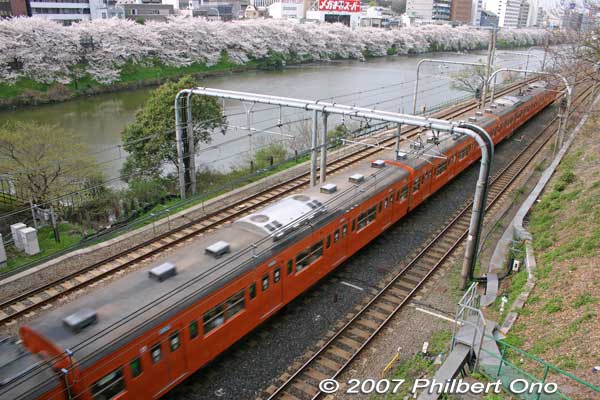
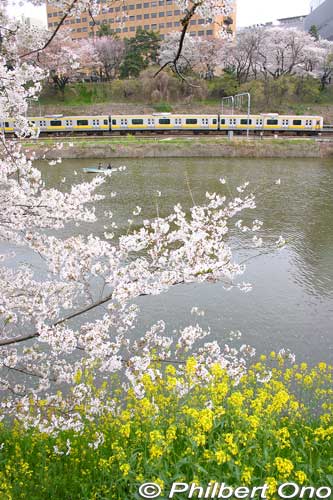
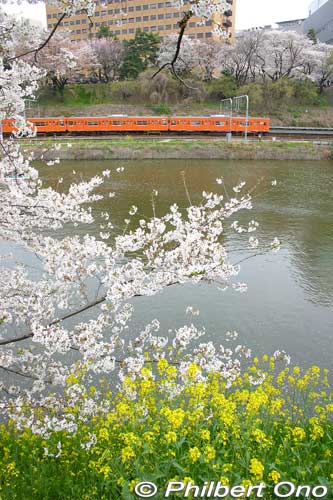
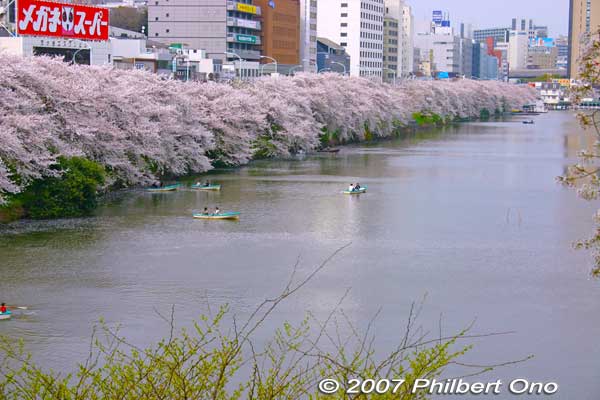
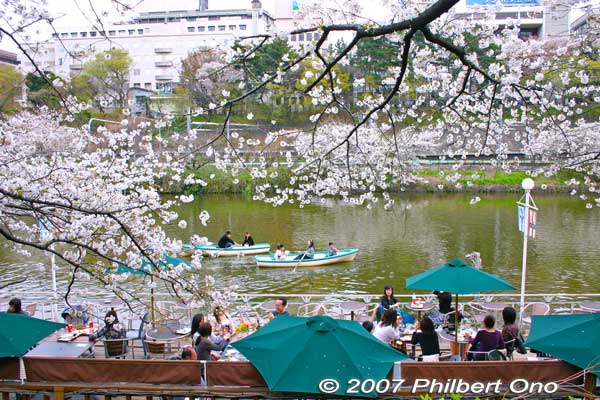
Ride the JR Chuo Line or Sobu Line in central Tokyo and you will see cherry blossoms along the parallel moat between Iidabashi Station and Ichigaya Station. Sotobori Canal was the outer moat of Edo Castle. You can also get off the train at Iidabashi or Ichigaya Station and walk under the cherry blossoms along the canal.
Train fans will enjoy photographing the trains and cherry blossoms. Not geared for picnicking except for the Canal Cafe. Map here.
 Yanaka Cemetery (谷中霊園), Taito-ku
Yanaka Cemetery (谷中霊園), Taito-ku
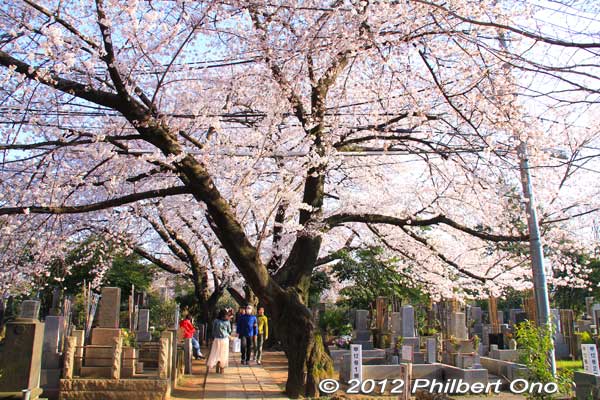
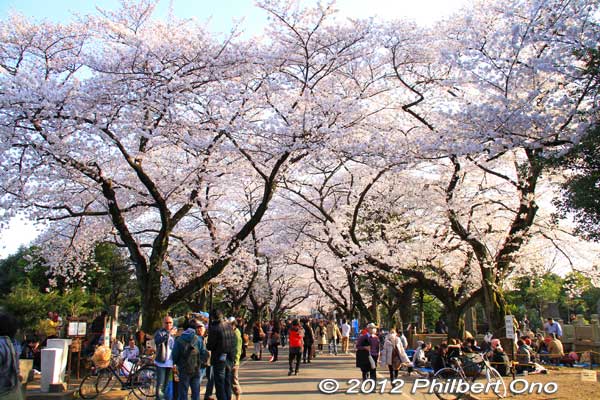
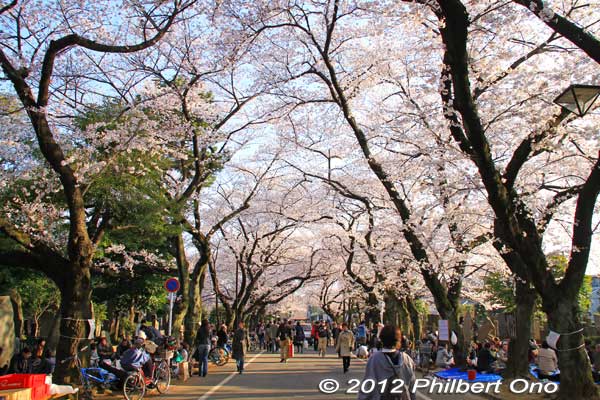
Most of Tokyo’s major cemeteries have cherry blossoms. Yanaka is one of them with a lot of cherry blossoms. They also allow hanami picnics. Interesting contrast with gravestones. Then again, it might make the departed souls happy to be in their midst.
Yanaka Cemetery is near Ueno Park. If you have time, you can see both.
The cemetery is noted for graves of famous people like actor Hisaya Morishige, Eiichi Shibusawa, Yokozuna Dewanoumi, artist Taikan Yokoyama, and the last Tokugawa shogun Yoshinobu, but they are off limits to the public. Nearby Tennoji temple is also nice to visit with a weeping cherry tree. Near JR Nippori Station. Map here.
 Zojoji Temple and Shiba Park (増上寺・芝公園), Minato-ku
Zojoji Temple and Shiba Park (増上寺・芝公園), Minato-ku
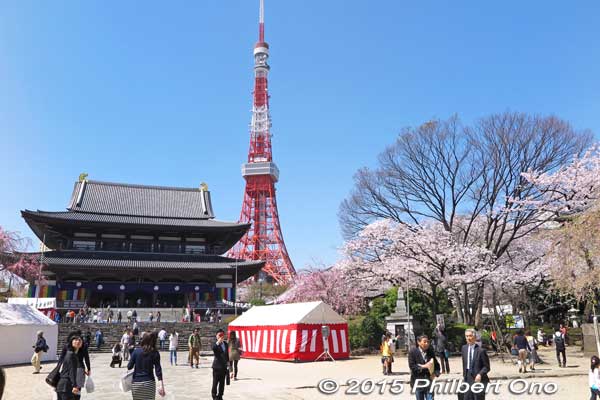


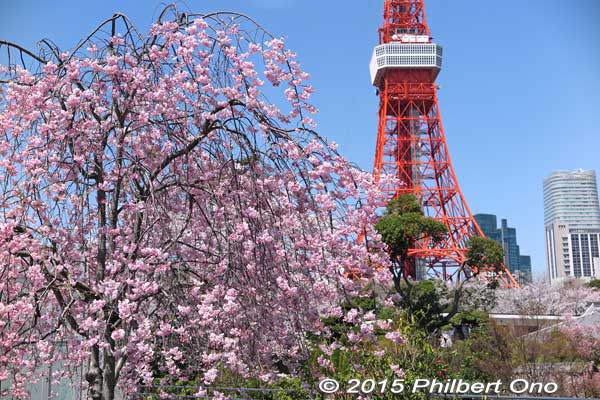
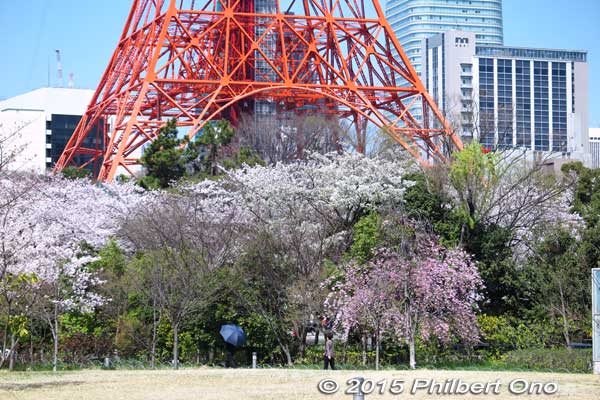
If you like temples and samurai, this is the place. Zojoji was the official Buddhist temple of the Tokugawa shoguns. You can see the tombs of some of the shoguns and their wives and children. Tokyo Tower is also ever present in the background.
Neighboring Shiba Park also has cherry blossoms and fine views of Tokyo Tower. Near Onarimon Station on the Mita subway line, Daimon Station on the Toei Oedo and Asakusa subway lines, and JR Hamamatsu-cho Station. Map here.
 Yoyogi Park (代々木公園), Shibuya-ku
Yoyogi Park (代々木公園), Shibuya-ku
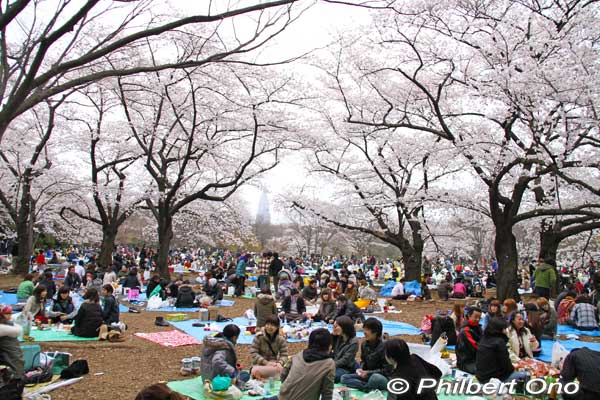
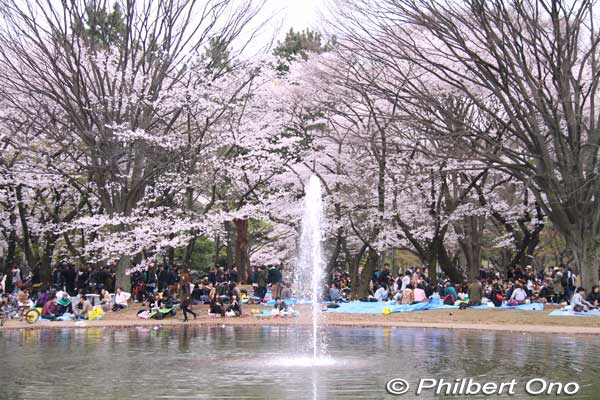
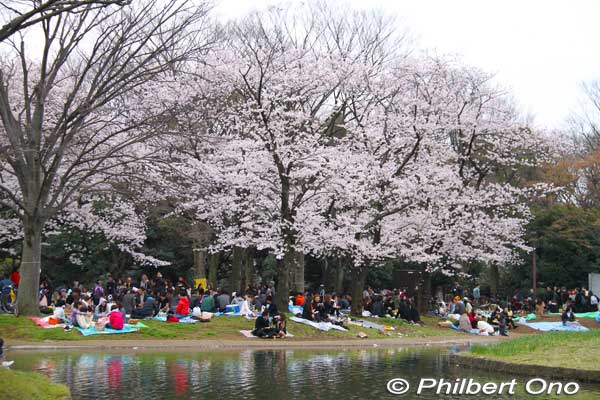
Another park popular with hanami picnickers. Smaller than Ueno Park and Shinjuku Gyoen Garden. There is more open space than cherry trees, so many people picnic under the sky instead of a cherry tree. Very long lines for restrooms, especially for ladies. Adjacent to Meiji Shrine. Near JR Harajuku Station (Yamanote Line) and Yoyogi-Koen Station on the Chiyoda Line and . Map here.
 Meguro River (目黒川桜まつり), Meguro-ku
Meguro River (目黒川桜まつり), Meguro-ku
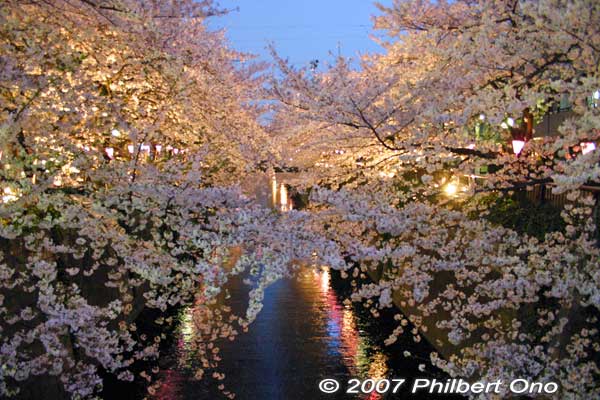
Very crowded in the evening when the cherry blossoms are lit up along the river. No picnicking allowed. Just stroll and look. From Naka-Meguro Station (Hibiya Line), the road is narrow at first and passing cars are a nuisance. No riverside foot path until you walk further toward JR Meguro Station. Map here.
Western Tokyo
 Inokashira Park (井の頭公園), Mitaka
Inokashira Park (井の頭公園), Mitaka
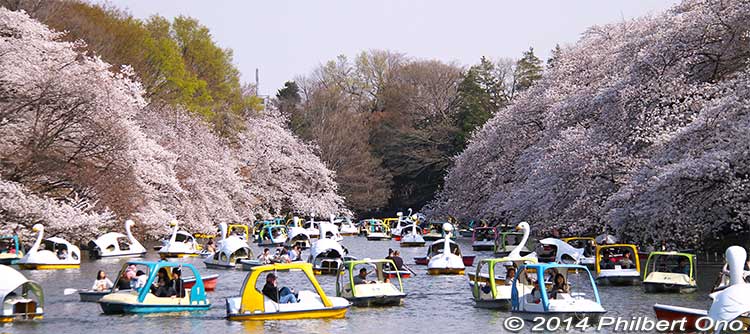
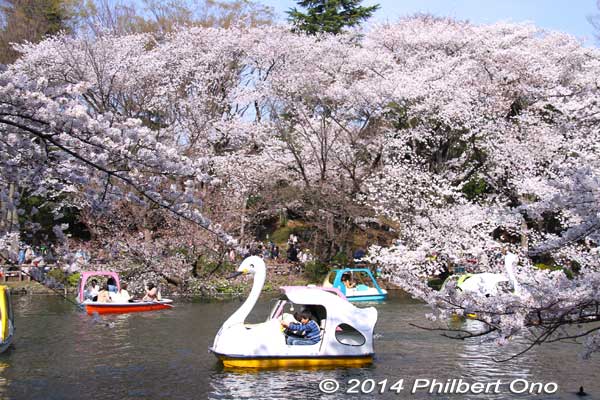
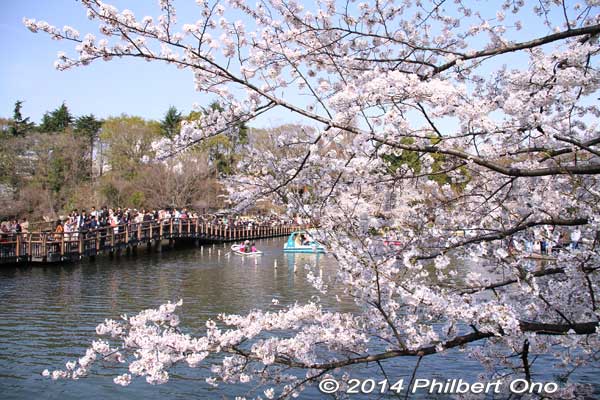
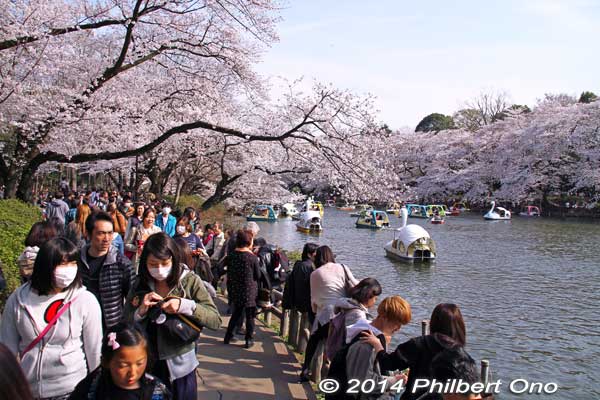
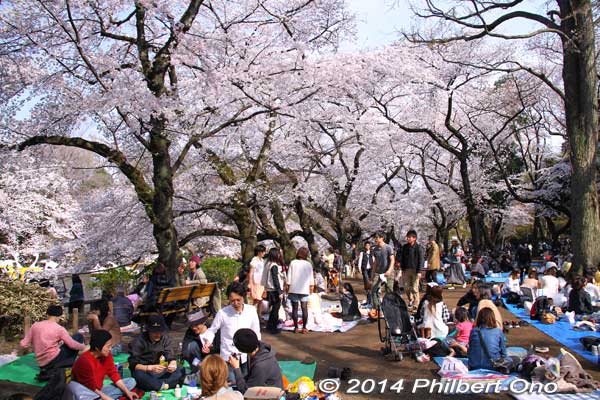
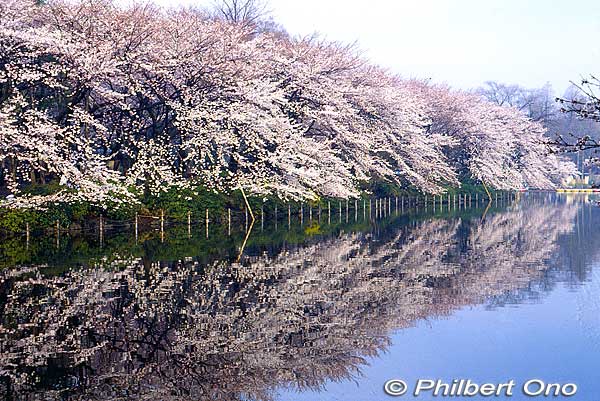
Inokashira Park has always been a local favorite in western Tokyo. The park is built around Inokashira Pond. Much of the pond is lined with cherry blossoms and you can walk completely around the pond.
The highlight activity is renting a rowboat or swan boat on the pond. The hanami picnic areas are mostly dirt, not grass, so bring a picnic mat to sit on. There’s also a zoo. Near Kichijoji Station. Map here.
 Koganei Park (小金井公園), Koganei
Koganei Park (小金井公園), Koganei
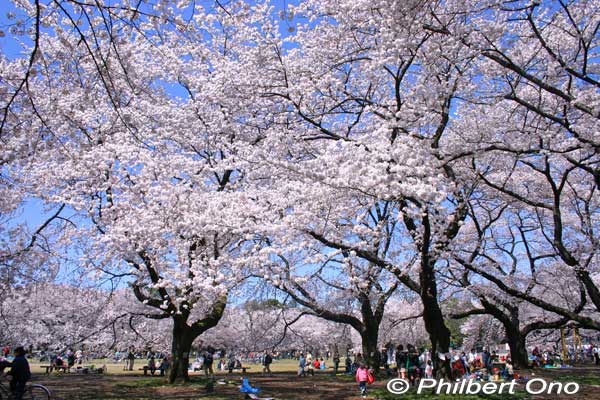
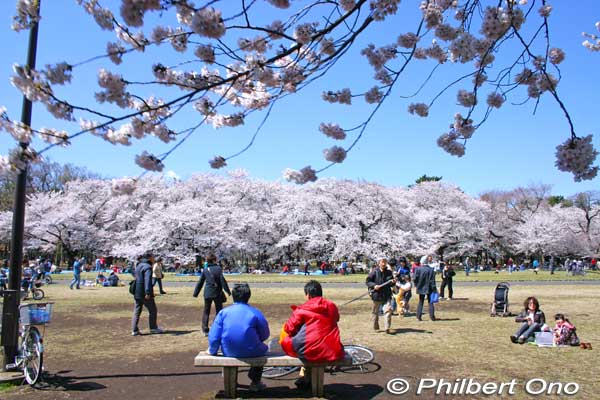
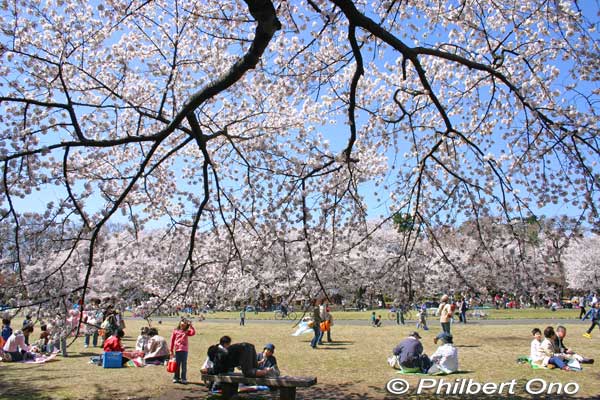
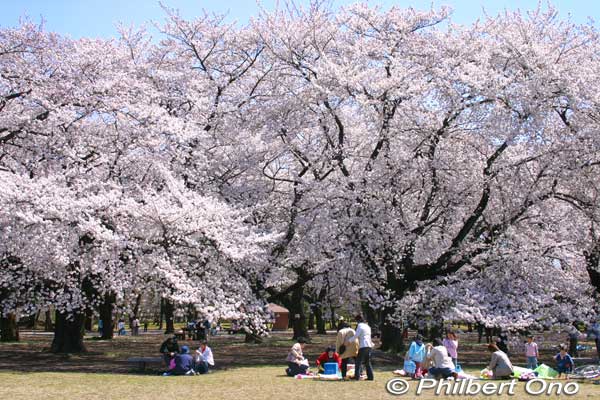

I would call this the biggest and most impressive sakura spot in western Tokyo. When in full bloom, the huge, almost monstrous trees are just fantastic.
Within the park is the Edo-Tokyo Open-Air Architectural Museum, an outdoor museum of architecture of 27 reconstructed buildings originally from the Edo Period and up to the 1930s. Highly recommended. Near Musashi-Koganei Station on the JR Chuo Line (30 min. from Shinjuku Station). At the north exit, go to bus stop 2 or 3 and take the Seibu bus and get off at Koganei Koen Nishiguchi. Map here.
Eastern Tokyo
These cherry blossom spots in eastern Tokyo are local favorites with hardly any tourists.
 Kinshi Park Cherry Blossoms (錦糸公園の桜), Sumida-ku
Kinshi Park Cherry Blossoms (錦糸公園の桜), Sumida-ku
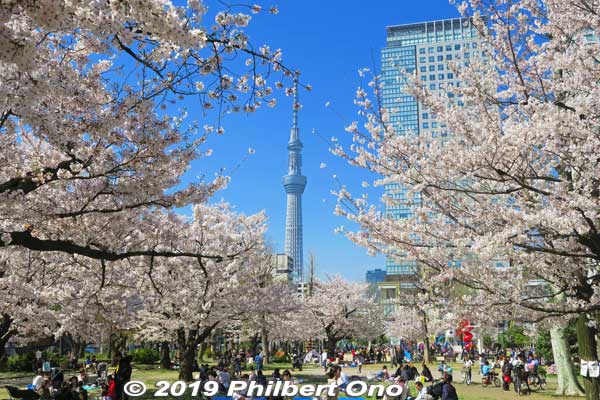
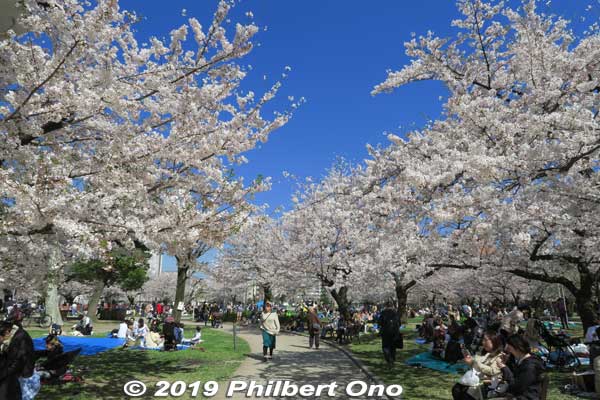
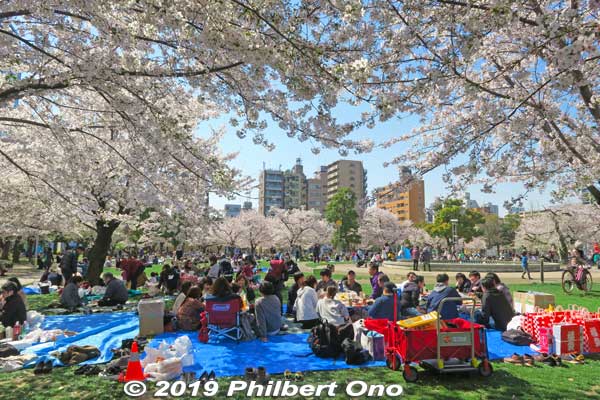
Right near JR Kinshicho Station (JR Sobu and Yokosuka Lines), Kinshi Park is a neighborhood oasis especially during cherry blossom season with 162 cherry blossom trees. Cherry blossom picnickers have excellent views of Tokyo Skytree too.
The park also has tennis courts, playground equipment, and a public gymnasium. The park opened in July 1928. Near JR Kinshicho Station (JR Sobu Line), north exit. Map here.
 Oyoko River in Fukagawa (大横川), Koto-ku
Oyoko River in Fukagawa (大横川), Koto-ku
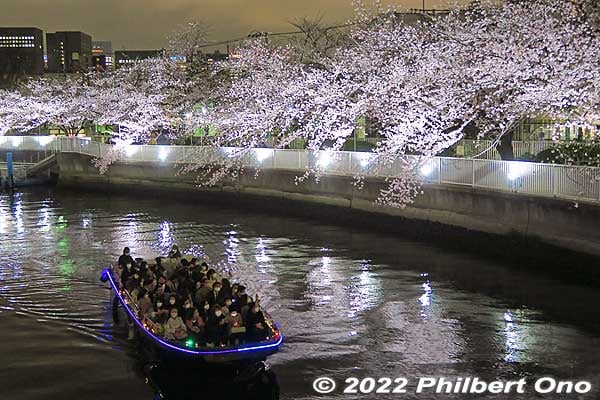
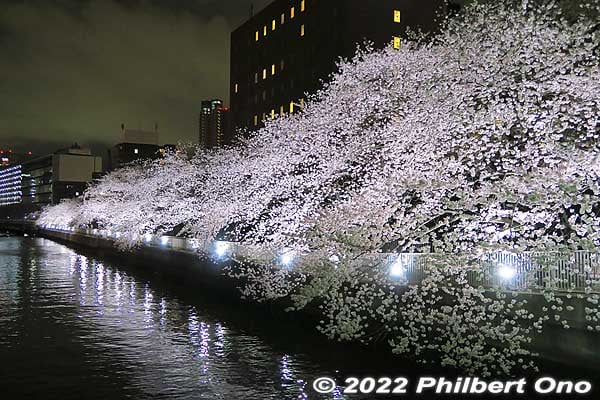

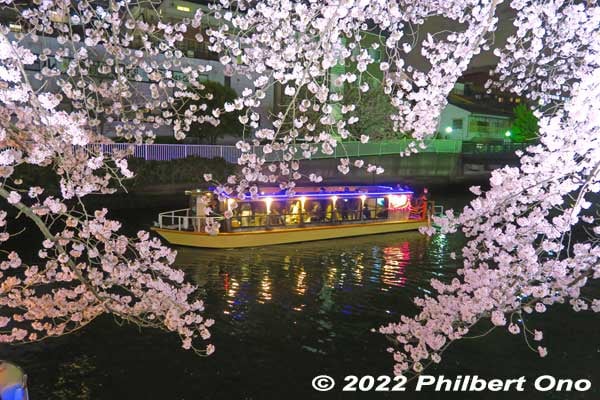
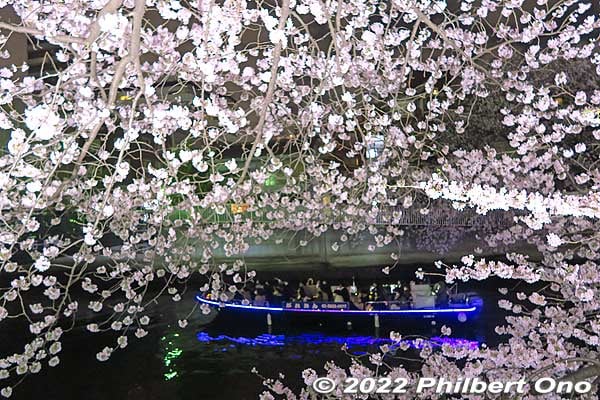
In Monzen-Nakacho in Fukagawa, Tokyo, Oyoko River (大横川) is lined with cherry blossoms and lit up with LEDs from 5:00 pm to 10:00 pm during sakura season from mid-March to early April.
On the weekends, food stalls and river boat rides are available.
For pedestrians, it’s not crowded at all under the cherry blossoms. However, no hanami picnicking. Cherry blossom river boat rides are popular. They operate every day and evening during the cherry blossom season.
Traditional Japanese wooden wasen boats (和船) also offer boat rides on weekends, but reservations fill up well before March. If it rains, boat rides will be canceled. The dock is near Kurofune Bridge. For more info and reservations, click here (in Japanese).
Oyoko River is near Monzen-Nakacho Station on the Tozai subway line and Oedo Line. Map here.
 Shinkawa River Senbonzakura Cherry Blossoms (新川千本桜), Edogawa-ku
Shinkawa River Senbonzakura Cherry Blossoms (新川千本桜), Edogawa-ku
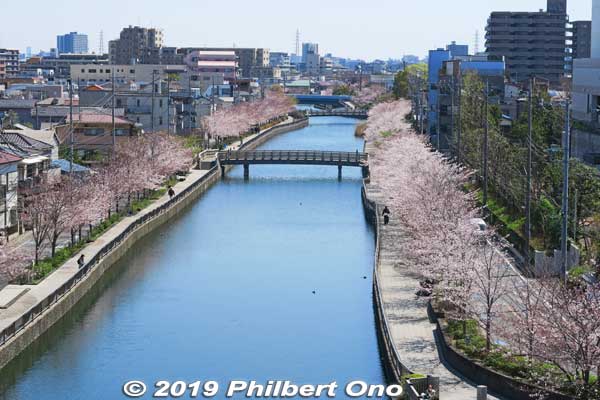
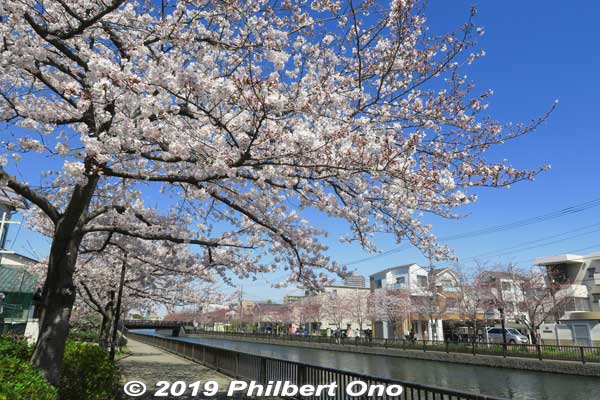
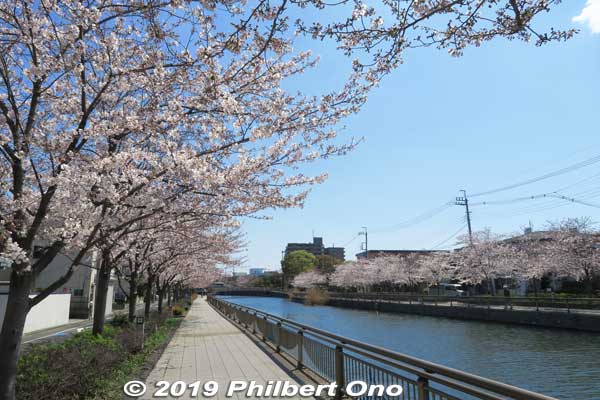
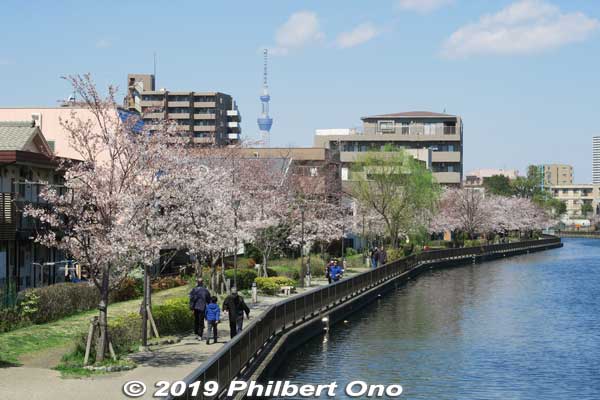
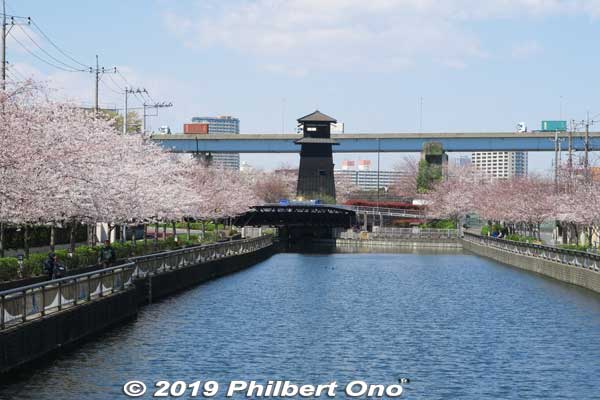
Shinkawa River cuts across Edogawa Ward east to west for 3 km between Kyu-Edo River and Arakawa River. The entire length has a nice riverside walkway on both sides. In late March to early April, over 700 cherry trees bloom (20 varieties, mainly Somei-Yoshino).
The cherry trees were planted from April 2007 for a project called the “Shinkawa Senbonzakura Plan” to plant cherry blossoms on both sides of the river to create an Edo Period look. It’s a very pleasant walk with no crowds, no tourists.
The west end of Shinkawa River has a Edo-style fire watchtower. It’s wooden and 15 meters high. There originally was no such fire tower here. Built only as a tourist attraction. You can go up the Fire Watchtower for fine views of the surrounding area.
From April 2007, a new project called the “Shinkawa Senbonzakura Plan” was started to plant cherry blossoms on both sides of the river to create an Edo Period look. The river walk was also made earthquake resistant. Walkable from Funabori Station on the Toei Shinjuku Line. Map here.
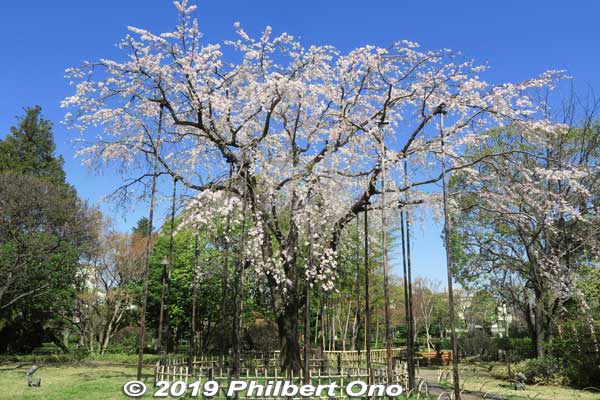
 Komatsugawa Cherry Blossoms (小松川千本桜), Edogawa-ku
Komatsugawa Cherry Blossoms (小松川千本桜), Edogawa-ku
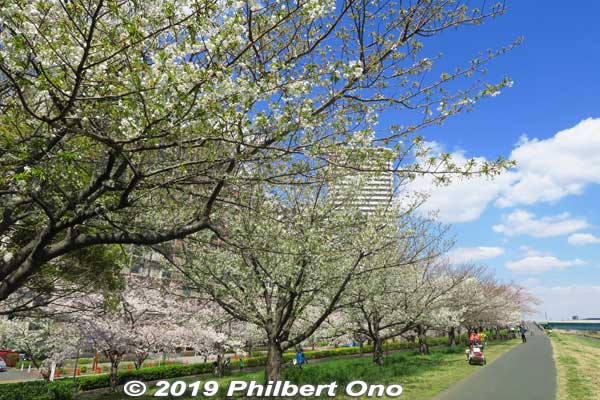
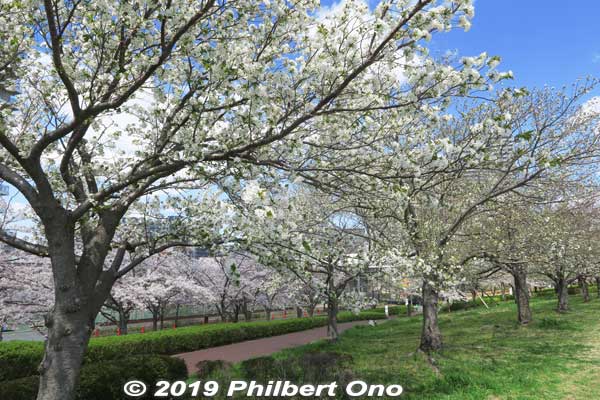
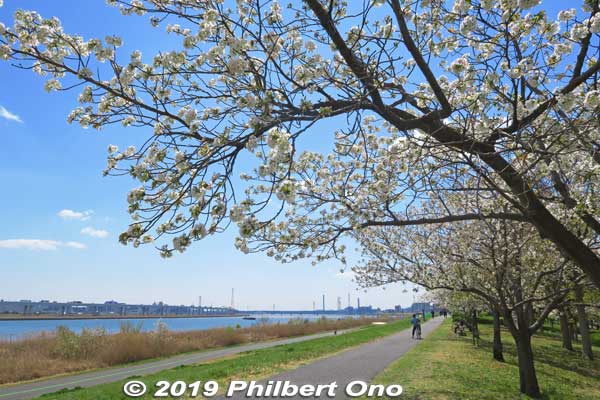
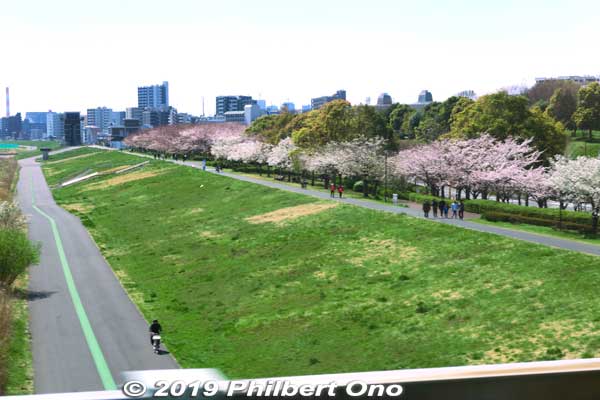
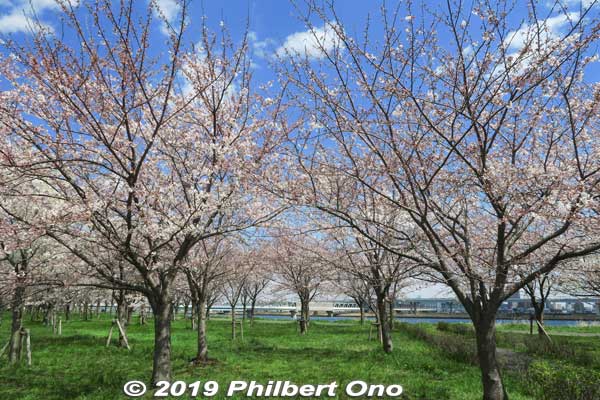
Komatsugawa Cherry Blossoms (Komatsugawa Senbon-zakura) are along the west side of Arakawa River in Edogawa Ward/City. They line the pedestrian and cycling path on the riverbank. Very nice. Cycling or walking here when the cherry blossoms are in bloom is very pleasant. Near Higashi-Ojima Station on the Toei Shinjuku Line. Map here.
 Essential Cherry Blossom Vocabulary
Essential Cherry Blossom Vocabulary
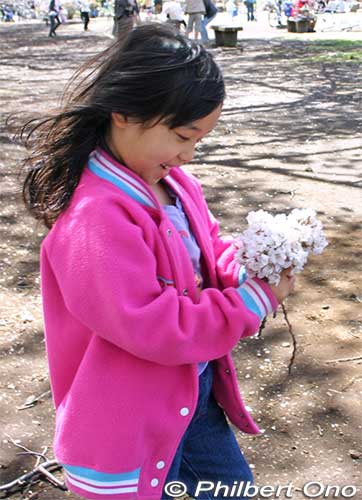
- sakura さくら or 桜 – Cherry blossom and Japan’s national symbol and flower. By far, it is the most celebrated flower in Japan.
- tsubomi つぼみ – Flower buds.
- shichibu-zaki 七分咲き – Cherry blossoms in 70% bloom which is right before they reach full bloom. News reports consider 80% bloom to be full bloom (mankai).
- sakura zensen 桜前線 – Cherry blossom front as they bloom across Japan from Okinawa to Hokkaido.
- kaika 開花 – Flowers started blooming. This is about a week before the tree reaches full bloom.
- mankai 満開 – Full bloom. You will hear this on the news often.
- hayasaki 早咲き – Early-blooming flowers. A few varieties of cherry blossoms bloom earlier than usual.
- hanami or ohanami 花見 – Flower-viewing picnic (often with alcohol) under the cherry blossoms at a park. The most common way to celebrate spring under the flowers and commonly seen in the news. Hanami picnics are usually not allowed in shrines and temples.
- sakura matsuri さくらまつり or 桜祭り- Cherry blossom festival. Not a religious festival, but can take the form of various events and stage entertainment.
- Somei Yoshino 染井吉野 – The most common and coveted species of cherry blossoms whose light pink (almost white) flowers bloom in fluffy bunches on the tree.
- kawazu-zakura – Species of early-blooming cherry blossom, usually in early March. Very pink.
- yo-zakura 夜桜 – Cherry blossoms lit up at night. Some temples and parks light up the flowers at night.
- shidare-zakura しだれ桜 or 枝垂桜 – Weeping cherry blossoms with long, hanging branches of flowers.
- Sakura Meisho さくら名所 – Famous cherry blossom spot. It is most often a castle, public park, garden, shrine/temple, or riverside.
- Sakura, Sakura さくら さくら- Famous folk song about cherry blossoms.
- chiru, chitta 散る、散った – Flowers fell off the tree. Happens a few days after full bloom when the petals fall like pink snow.
- sakura fubuki さくら吹雪 – Swirling cherry blossom petals. Occurs when the wind blows off the flower petals, creating a pink snow.
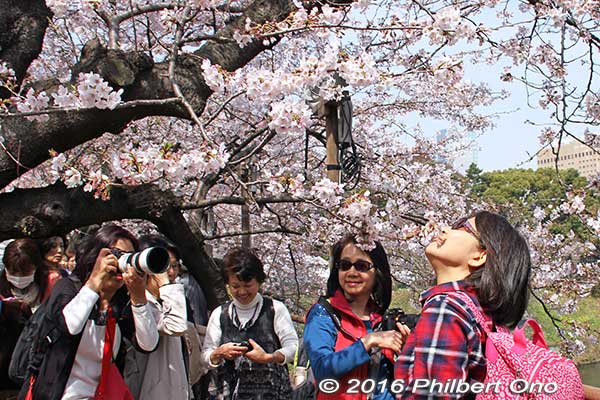
 Other notable sakura spots in Tokyo:
Other notable sakura spots in Tokyo:
Aoyama Cemetery (青山霊園) – Minato Ward, Near Gaienmae Station (Ginza/Hanzomon Line) and Nogizaka Station (Chiyoda Line).
Asukayama Park (飛鳥山公園) – Kita Ward, Near Oji Station on the Keihin-Tohoku Line.
Fuchu Sakura Matsuri (府中市民桜まつり) – Fuchu, Near Fuchu Station on the Keio Line from Shinjuku.
Kunitachi Daigaku-dori (国立大学通り〜さくら通り) – Near JR Kunitachi Station.
Nakano-dori – Nakano Ward, Near Nakano Station.
Senzoku-ike Pond (洗足池) – Ota Ward, Near Senzoku-Ike Station on the Tokyu Ikegami Line.
Showa Kinen Park (昭和記念公園) – Tachikawa, near JR Nishi-Tachikawa Station.
Shakujii Park (石神井公園) – Nerima-ku, Near Shakujii-Koen Station on the Seibu Ikebukuro Line.
Tama Cemetery (多摩霊園) – Fuchu, Near Tama Station on the Seibu Tamagawa Line or a 2-minute walk from Reien Omotemon bus stop via Keio Bus from JR Musashi-koganei Station.
Shakujii River Cherry Blossoms (石神井川の桜並木) – Itabashi-ku, near Shin-Itabashi Station on the Mita subway line.
